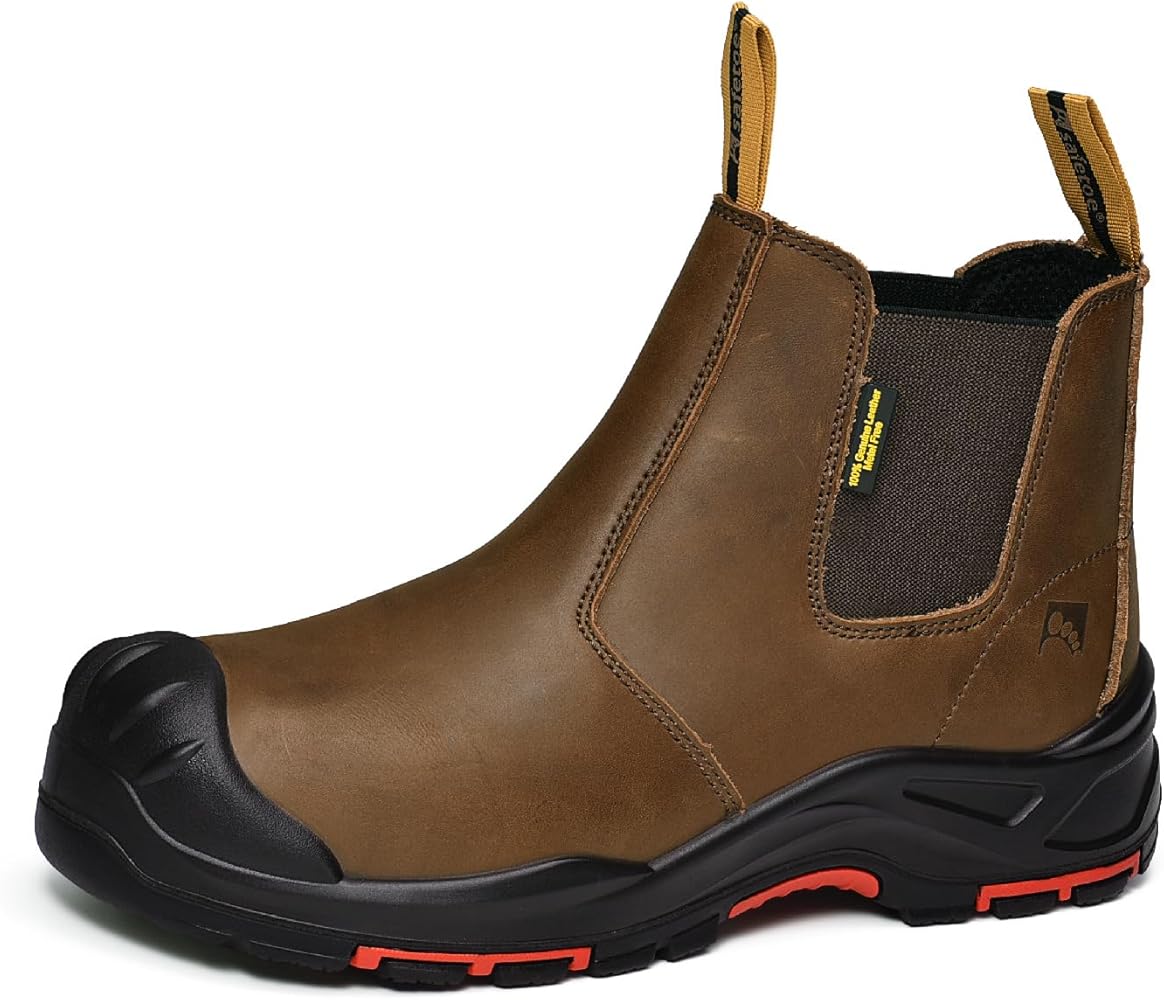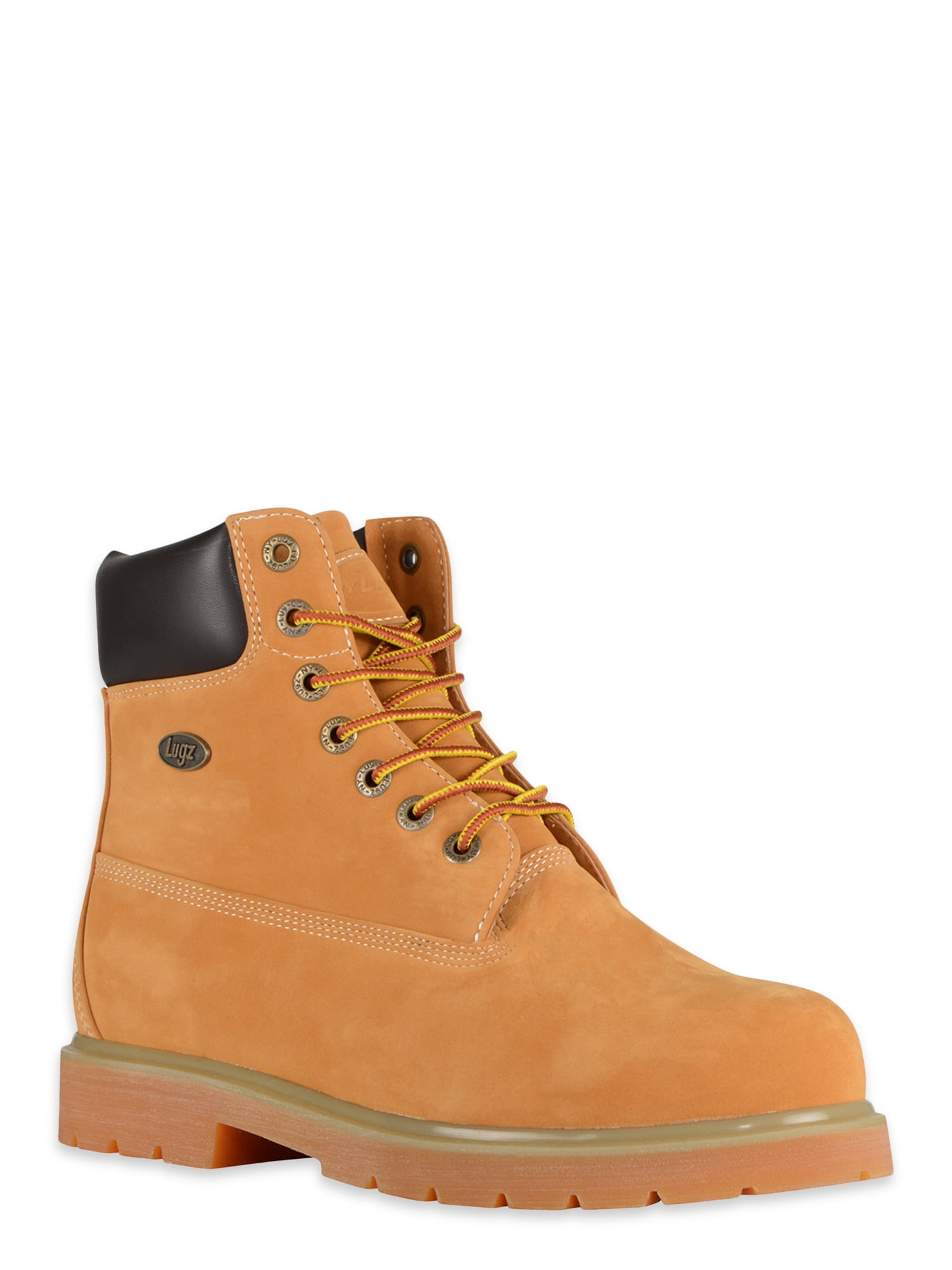
Men’s work boots slip on are a type of footwear designed for use in occupational settings that require both safety and convenience. They are characterized by their slip-on design, which allows for quick and easy wear without the need for laces or buckles.
The importance of men’s work boots slip-on lies in their ability to provide both protection and comfort in demanding work environments. They are typically made from durable materials such as leather or synthetic fibers, which offer protection against hazards like punctures, abrasions, and electrical shocks. Additionally, they often feature slip-resistant outsoles, which enhance stability and prevent falls on slippery surfaces. The slip-on design, combined with cushioned insoles and ergonomic features, contributes to the comfort of these boots, ensuring that workers can wear them for extended periods without experiencing fatigue or discomfort.
Men’s work boots slip-on have a long history of use in various industries, including construction, manufacturing, mining, and transportation. They have evolved over time to meet the specific needs of different work environments, with specialized designs for different types of hazards and conditions. Today, they are essential safety gear for many workers, providing reliable protection and comfort on the job.
1. Safety
The safety aspect is paramount in men’s work boots slip on, as they are designed to protect workers’ feet from various hazards encountered in occupational settings. These boots incorporate several safety features to ensure the well-being of workers.
- Puncture Resistance: These boots are crafted with puncture-resistant materials, such as thick leather or reinforced synthetic fibers, to safeguard feet from sharp objects like nails or debris that may penetrate ordinary footwear.
- Abrasion Resistance: The boots are made from durable materials that resist abrasions and lacerations, protecting feet from friction and contact with rough surfaces, such as concrete or metal.
- Electrical Hazard Protection: For workers in electrical environments, these boots feature electrical hazard protection, which insulates feet from electrical currents, reducing the risk of electrical shocks.
- Slip Resistance: Slip-resistant outsoles enhance stability and prevent falls on slippery surfaces, which is crucial in workplaces with wet or oily floors.
These safety features collectively contribute to the protective nature of men’s work boots slip on, ensuring that workers can perform their duties with confidence, knowing that their feet are shielded from potential hazards.
2. Convenience
The convenience factor is a key aspect of men’s work boots slip on, as it directly impacts the wearer’s efficiency and comfort on the job. The slip-on design eliminates the need for laces or buckles, allowing workers to wear and remove their boots quickly and effortlessly. This saves valuable time, especially in fast-paced or demanding work environments where every second counts.
The ease of wear also contributes to the overall comfort of these boots. Workers can slip them on and off without any hassle, reducing fatigue and discomfort, particularly during long shifts or when working in awkward positions. This convenience is particularly beneficial in situations where workers need to frequently remove their boots, such as when entering and exiting hazardous areas or when performing tasks that require specialized footwear.
Moreover, the slip-on design allows for easy adjustment and a secure fit. Workers can quickly adjust the tightness of the boots to suit their preferences and ensure a comfortable fit throughout the day. This is especially important in physically demanding jobs where foot stability and support are crucial for preventing injuries.
3. Comfort
Comfort is a crucial aspect of men’s work boots slip on, as workers often spend long hours on their feet in demanding environments. The combination of cushioned insoles and ergonomic features in these boots plays a vital role in ensuring the wearer’s comfort and well-being throughout the day.
-
Cushioned Insoles:
Cushioned insoles provide exceptional comfort by absorbing shock and reducing pressure on the feet. This is particularly important in jobs that involve standing or walking on hard surfaces. The cushioning effect helps to prevent fatigue, aches, and pains, allowing workers to stay focused and productive. -
Ergonomic Features:
Ergonomic features, such as arch support and heel cushioning, are designed to conform to the natural contours of the feet. This provides optimal support and reduces stress on the feet, ankles, and legs. Ergonomic boots help to prevent common foot problems like plantar fasciitis and heel spurs, ensuring long-lasting comfort. -
Breathability:
In addition to cushioning and ergonomic features, many men’s work boots slip on are designed with breathable materials that allow air to circulate around the feet. This helps to regulate temperature, preventing sweaty and uncomfortable feet, even during extended wear. -
Lightweight Construction:
Lightweight construction is another important factor contributing to the comfort of these boots. Heavy boots can put unnecessary strain on the feet and legs, leading to fatigue and discomfort. Lightweight boots reduce this strain, allowing workers to move around more easily and comfortably.
The combination of these comfort-enhancing features makes men’s work boots slip on an ideal choice for workers who prioritize their well-being and productivity. By providing exceptional comfort during extended wear, these boots help workers to stay focused, reduce fatigue, and minimize the risk of foot-related injuries.
4. Durability
The durability of men’s work boots slip on is a crucial element that contributes to their effectiveness in demanding work environments. The use of durable materials, such as leather or synthetic fibers, ensures that these boots can withstand the rigors of various job sites and protect the wearer’s feet.
The durability of these boots is important for several reasons. First, it ensures that the boots provide long-lasting protection for the wearer’s feet. In harsh work environments, boots can be subjected to a range of hazards, including punctures, abrasions, and chemical spills. Durable materials, like leather, offer excellent resistance to these hazards, ensuring that the boots maintain their protective qualities over time.
Second, durability contributes to the overall cost-effectiveness of men’s work boots slip on. Durable boots can withstand extended use and require less frequent replacement, which can save businesses money in the long run. This durability also reduces downtime for workers, as they don’t have to spend time replacing worn-out boots.
Furthermore, durable boots are more sustainable than those made from less durable materials. By lasting longer, they reduce the need for frequent disposal and replacement, minimizing waste and environmental impact.
In conclusion, the durability of men’s work boots slip on is a key factor in their effectiveness and overall value. By utilizing durable materials, these boots provide long-lasting protection, cost-effectiveness, and sustainability, making them an essential investment for workers in demanding environments.
5. Slip Resistance
Slip resistance is a crucial aspect of men’s work boots slip on, especially in hazardous work environments where slippery surfaces pose a significant risk of accidents and injuries. Slip-resistant outsoles play a vital role in ensuring the safety and well-being of workers.
- Enhanced Stability: Slip-resistant outsoles provide exceptional grip and traction on slippery surfaces, such as wet floors, oily surfaces, or icy pavements. This enhanced stability helps workers maintain their footing and prevents slips and falls, reducing the risk of injuries.
- Improved Safety: By preventing slips and falls, slip-resistant outsoles contribute to the overall safety of workers. In industries such as construction, manufacturing, and healthcare, where slippery surfaces are common, these boots provide a crucial layer of protection, minimizing the likelihood of accidents.
- Increased Confidence: Workers wearing slip-resistant boots experience increased confidence and peace of mind when navigating slippery surfaces. They can move around more freely and focus on their tasks without worrying about losing their footing, leading to improved productivity and efficiency.
- Compliance with Regulations: In many workplaces, slip-resistant footwear is a requirement to comply with safety regulations and standards. Men’s work boots slip on that meet these standards ensure that workers are in compliance and protected from potential hazards.
In conclusion, the slip resistance of men’s work boots slip on plays a vital role in enhancing stability, improving safety, increasing confidence, and ensuring compliance with regulations. By providing exceptional grip and traction on slippery surfaces, these boots protect workers from accidents and injuries, contributing to a safer and more productive work environment.
FAQs on Men’s Work Boots Slip On
This section addresses frequently asked questions about men’s work boots slip on, providing concise and informative answers to common concerns and misconceptions.
Question 1: Are work boots slip on safe for demanding work environments?
Answer: Yes, men’s work boots slip on are designed to meet the safety requirements of various work environments. They incorporate features such as puncture resistance, electrical hazard protection, and slip-resistant outsoles to safeguard workers from potential hazards.
Question 2: Do slip-on work boots offer enough support and stability?
Answer: Yes, many slip-on work boots are equipped with ergonomic features like arch support and heel cushioning to provide optimal support and stability. They are designed to conform to the natural contours of the feet, reducing fatigue and the risk of foot injuries.
Question 3: Are these boots comfortable for extended wear?
Answer: Yes, men’s work boots slip on prioritize comfort. They often feature cushioned insoles, breathable materials, and lightweight construction to ensure comfort during long shifts. These features help reduce fatigue and keep feet fresh and comfortable.
Question 4: How durable are slip-on work boots?
Answer: Men’s work boots slip on are made from durable materials like leather or synthetic fibers to withstand the rigors of demanding work environments. They are designed to resist punctures, abrasions, and harsh conditions, ensuring long-lasting protection for the wearer’s feet.
Question 5: Are slip-on work boots suitable for slippery surfaces?
Answer: Yes, many men’s work boots slip on have slip-resistant outsoles that provide exceptional grip and traction on slippery surfaces. They are ideal for workplaces with wet or oily floors, or where there is a risk of slips and falls.
Question 6: Are these boots available in a range of styles and sizes?
Answer: Yes, men’s work boots slip on come in a variety of styles and sizes to suit different preferences and needs. They are available in various colors, designs, and materials, ensuring that workers can find the perfect fit and style for their workplace.
These FAQs provide valuable insights into the important features, benefits, and applications of men’s work boots slip on. By addressing common questions, this section aims to empower workers with the knowledge they need to make informed decisions when choosing the right footwear for their work environment.
Transition to the next article section:
Tips for Choosing Men’s Work Boots Slip On
Selecting the right pair of men’s work boots slip on is crucial for ensuring safety, comfort, and durability in demanding work environments. Here are five essential tips to guide your choice:
Tip 1: Prioritize Safety Features
- Look for boots with puncture-resistant and abrasion-resistant materials to protect your feet from sharp objects and friction.
- Choose boots with electrical hazard protection if you work near electrical equipment.
- Ensure the boots have slip-resistant outsoles for stability on slippery surfaces.
Tip 2: Ensure a Comfortable Fit
- Select boots that provide adequate toe room and arch support.
- Look for boots with cushioned insoles and moisture-wicking materials for breathability and comfort during extended wear.
- Consider boots with adjustable closures for a customized fit.
Tip 3: Choose Durable Materials
- Opt for boots made from high-quality leather or synthetic fibers that can withstand harsh conditions.
- Reinforced toes and heels enhance durability and protect against impact.
- Look for boots with sturdy stitching and construction for long-lasting performance.
Tip 4: Consider the Work Environment
- Choose boots with insulation for cold environments or moisture-resistant materials for wet environments.
- Select boots with appropriate slip resistance for the specific surface conditions of your workplace.
- Consider boots with additional features like metatarsal protection or ankle support if required for your job.
Tip 5: Maintain Your Boots Regularly
- Clean your boots regularly with a damp cloth or brush to remove dirt and debris.
- Apply leather conditioner to leather boots to preserve their durability and appearance.
- Replace worn-out insoles or outsoles promptly to maintain comfort and safety.
By following these tips, you can choose men’s work boots slip on that meet your specific needs and provide the protection, comfort, and durability required for demanding work environments.
Transition to the article’s conclusion:
Conclusion
Men’s work boots slip on are an essential piece of safety gear for workers in various industries. They combine protection, comfort, durability, and convenience to ensure the well-being and productivity of workers in demanding environments. The key aspects discussed in this article, including safety features, comfort-enhancing designs, durable construction, slip resistance, and maintenance tips, provide a comprehensive understanding of the importance and effectiveness of these boots.
Choosing the right pair of men’s work boots slip on is crucial for ensuring the safety and comfort of workers. By considering the specific needs of the work environment, prioritizing safety features, ensuring a comfortable fit, opting for durable materials, and maintaining the boots regularly, workers can make informed decisions that will safeguard their feet and enhance their performance on the job.



